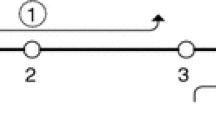Abstract
This paper presents a novel control algorithm to decrease the worst-case delay bound for high rate homogeneous and heterogeneous real-time flows when the network traffic load becomes heavy. The algorithm is adaptive based on the instantaneous network situations. It employs a generalized form of traditional (σ,ρ) regulator called the generalized (σ,ρ,λ) regulator that operates like the (σ,ρ) regulator under the normal network traffic load situation, but provides more regulations for the heavy network traffic load situation. For a set of real-time flows, we can show that D rg ≤D g where D rg and D g are the worst-case delay bounds with the (σ,ρ,λ) regulator and the (σ,ρ) regulator respectively. More specifically, we have developed a set of formulas to set the parameters for the new regulator so as to reduce the worst-case delay bounds for the real-time flows. We can prove that there exists a threshold input rate ρ* such that D rg = D g for ρ≤ρ* and D rg < D g for ρ > ρ*. When the average input rate of real-time flows is very high, the generalized regulator can effectively control the delay. The extensive experiment data match our theoretical results.
Similar content being viewed by others
References
Cruz R (1991) A calculus for network delay, Part I: Network elements in isolation. IEEE Trans. Information Theory, 37(1):114–131
Cruz R (1991) A calculus for network delay, Part II: Network analysis. IEEE Trans. Information Theory, 37(1):131–141
Turner J (1986) New directions in communications. IEEE Commun. Mag. 24(10):8–15
Sidi M, Liu WZ, Cidon I, Gopal I, (1989) Congestion control through input rate regulation. In Proc. IEEE Globecom ’89, 1764–1768
Echberg AE, Luan DT, Lucantoni DM (1990) An approach to controlling congestion in ATM networks. Int. J. Digital Analog Commun. Syst. 3:199–209
Tsai JT, Cruz RL (1999) Architectures for optical time-based traffic regulators, Global Telecommunications Conference-Globecom 1002–1006.
Chang CS (2000) Performance guarantees in communication networks, Springer, London
Verma D, Zhang H, Ferrari D (1991) Guaranteeing delay jitter bounds in pachet switching networks. In Proc. Tricomm Chapel Hill, NC, 35–46
Golestani S (1990) A stop-and-go queueing framework for congestion management. In Proc. ACM SIGCOMM Philadelphia, PA, 8–18
Zhang H, Ferrari D (1993) Rate-controlled static priority queueing. In Proc. IEEE INFOCOM San Francisco, CA, 227–236
Zhang H (1995) Service disciplines for guaranteed performance service in packet-switching networks. In Proc. the IEEE, 83(10)
Zhang H (1995) Providing end-to-end performance guarantees using non-work-conserving disciplines. Computer Communications: Special Issue on System Support for Multimedia Computing, 18(10)
Yaron O Sidi M (1993) Performance and stability of communication networks via robust exponential bounds. IEEE/ACM TRANSACTIONS ON NETWORKING, 1(3):372–385
Wroclawski J (1997) Specification of the controlled-load network element service. RFC 1884, IETF
Francini A, Chiussi FM (2000) Minimum-latency dual-leaky-bucket shapers for packet multiplexers-theory and implementation. Eighth International Workshop on Quality of Service, 19–28
Zeng S, Uzun N, Papavassiliou S, (2001) A dual level leaky bucket traffic shaper architecture for DiffServ networks. IEEE Workshop on High Performance Switching and Routing, 29–31, Dallas, Texas USA, 73–77
Li T, Rekhter Y (1998) A provider architecture for differentiated services and traffic engineering. RFC 2211, IETF
Parekh AK, Gallager RG (1993) A generalized processor sharing approach to flow control in integrated services network: the single-node case. IEEE/ACM TRANSACTIONS ON NETWORKING, 1(3):344–357
Demers A, Keshav S, Shenkar S (1990) Analysis and simulation of a fair queueing algorithm. Internet Research and Experience, (1)
Parekh A, Gallager R (1992) A generalized processor sharing approach to flow control—the single node case. In Proc. IEEE INFOCOM
Bennett JCR, Zhang H (1996) WF2Q: worst-case fair weighted fair queuing. In Proc. IEEE INFOCOM, San Fransico, CA, 120–128
Gerla M, Kleinrock L (1980) Flow control: a comparative survey. IEEE Transaction on Communications, 28:553–574
Berkeley UC (1999) LBL, USC/ISI, Xerox PARC. Ns notes and documentation, 20
Author information
Authors and Affiliations
Corresponding author
Additional information
The part of this paper has been appeared in The 23 rd IEEE International Conference on Distributed Computing Systems, 2003. The work is supported by CityU strategic grant Nos: 7001777 and 7001709 and CityU ARP Project No. 9610027. H. Wang was partially supported by National Natural Science Foundation of China (10471088, 60572126) and CityU strategic grant no. 7001709. Wanqing Tu is now with Department of Computer Science, The Hong Kong University of Science and Technology. Clear Water Bay, New Territories, Kowloon, Hong Kong.
Rights and permissions
About this article
Cite this article
Jia, W., Wang, H., Tu, W. et al. A New delay control method for real-time flows. J Comb Optim 12, 127–149 (2006). https://doi.org/10.1007/s10878-006-8908-9
Published:
Issue Date:
DOI: https://doi.org/10.1007/s10878-006-8908-9




